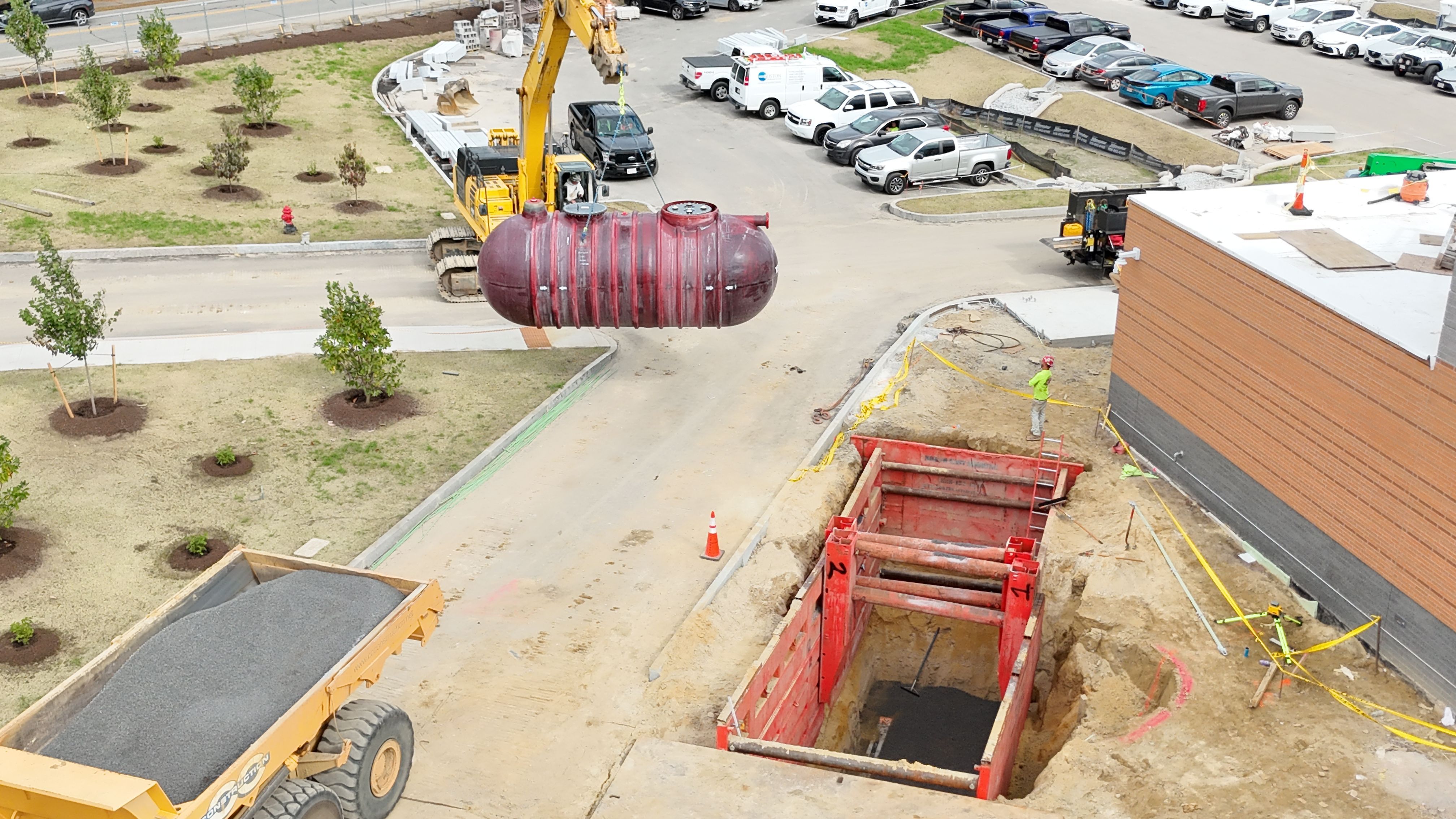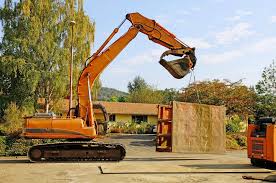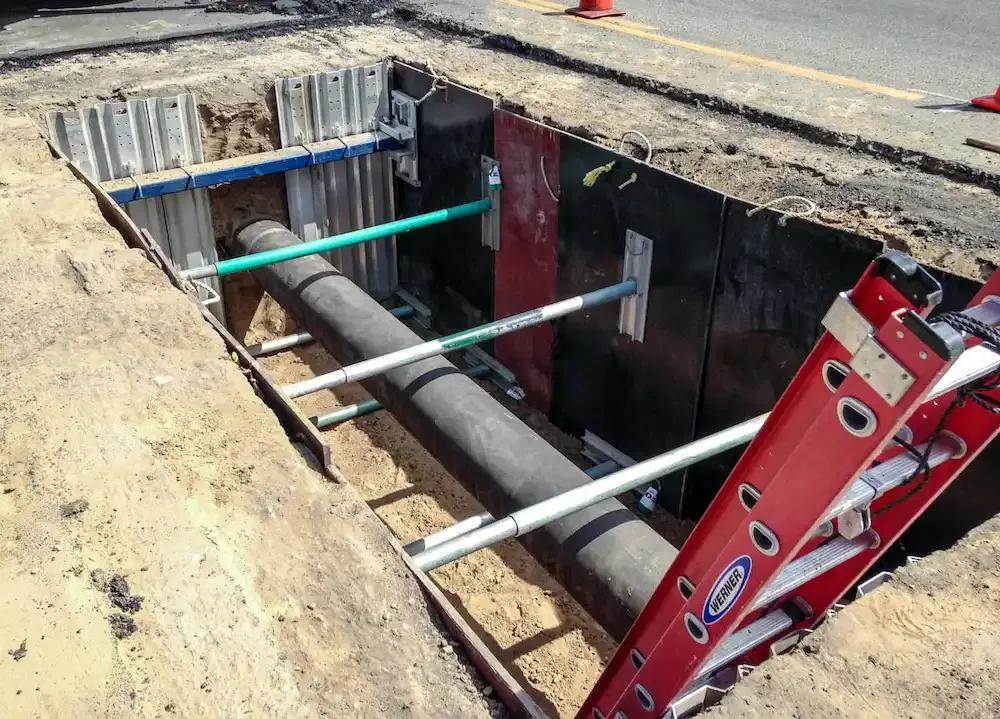What Is a Trench Box?
A trench box, sometimes called a trench shield, is a steel or aluminum structure used to protect workers when they’re working in an open trench. It doesn’t stop the walls from moving — it’s not shoring — but it gives a safe space if the sides of the trench give way.
Think of it like a safety cage. It’s built to hold back thousands of pounds of soil long enough for workers to stay safe and get out fast. Most trench boxes are made with sidewalls, steel spreaders, and lifting points to move them into place.
They're used on utility lines, pipe jobs, foundation work — anything where digging deep puts crews at risk.
It’s not just smart to use one. In most cases, it’s the law.
When Is a Trench Box Required?
If your trench is 5 feet deep or more, OSHA says you need some kind of protective system — and a trench box is one of the most common ways to meet that rule.
Here’s the breakdown
- Under 5 feet: A trench box might not be required, unless there’s a chance of collapse.
- 5 feet or deeper: You must protect your crew. That means using a trench box, sloping the walls, or using another approved method.
- 20 feet or deeper: A registered engineer must design the protective system.
These rules come straight from OSHA’s Subpart P for excavation safety.
But here’s the thing — depth isn’t the only risk. Wet soil, vibrations from nearby equipment, and unstable ground can cause a trench to cave in even at shallow depths. That’s why many contractors choose to use trench boxes any time there’s a chance of collapse, not just when the law says so.
If you’re asking yourself, “Do I need a trench box for this job?” — the safest answer is usually yes.
Choosing the Right Trench Box for the Job
Not every trench box fits every job. Picking the right one means looking at your depth, soil type, job duration, and crew size. You want something that keeps your people safe — without slowing the job down.
Here’s what to consider:
- Material
- Aluminum trench boxes are lightweight and easier to move. Great for small crews or utility work in tight spaces.
- Steel trench boxes are heavy-duty — better for deeper digs and tougher ground.
- Size and Depth Rating Always check the trench box’s rated depth. Going deeper than it’s built for is a serious safety risk.
- Adjustability Modular boxes can be stacked or extended, making them ideal for changing trench widths or deeper work.
- Soil Conditions Soft, sandy, or water-logged soil? Go heavier. Rocky or stable? You may have more options.
- Machine Access Will you be placing this box with a mini-excavator or full-size backhoe? Make sure the box is compatible with the equipment on-site.
The right trench box keeps your crew protected, meets OSHA standards, and lets you keep moving without second-guessing safety.
How to Use a Trench Box Safely
A trench box only works if you use it the right way. That means placing it before anyone enters the trench — and keeping it in position while work happens.
Here’s a safe-use checklist
Before You Start
- Inspect the trench box for damage — bent rails, cracked welds, or missing spreaders.
- Know your trench depth and soil type so you can choose the right box and placement.
- Make sure the box has lifting points for safe handling.
Installing the Box
- Place the box using a backhoe or excavator — never by hand.
- Lower it into the trench with nobody inside.
- Set it as close to the work area as possible, while keeping full wall coverage.
While Working
- Stay inside the box at all times. The walls protect you — the open ends do not.
- Don’t move the box while someone is inside.
- Keep heavy equipment and spoil piles at least 2 feet from the trench edge.
Removing the Box
- Exit the trench.
- Use lifting equipment to pull the box out — never attempt to shift it manually.
Remember, a trench box doesn’t stop a collapse — it gives you a protected zone if one happens. If you’re stepping outside the box, you’re stepping into risk.
Trench Box vs. Trench Shoring: What’s the Difference?
Trench boxes and trench shoring both protect workers in the trench — but they work in completely different ways.
A trench box protects workers if the walls cave in.
It doesn’t stop the collapse — it shields the crew inside from falling dirt.
Trench shoring supports the trench walls to help prevent a collapse.
It uses hydraulic pressure, timber, or other systems to hold the soil in place.
| Feature | Trench Box | Trench Shoring |
|---|---|---|
| Purpose | Shields workers | Supports trench walls |
| Collapse Control | Doesn’t prevent — contains | Designed to prevent collapse |
| Materials | Steel or aluminum | Timber, hydraulic, or mechanical |
| Installation | Lowered in after trench is dug | Installed as trench is excavated |
| Best For | Open areas with firm ground | Tight spaces or unstable soils |
So which one do you need?
- Use a trench box when you need fast setup, reusable gear, and protection in deeper trenches.
- Use shoring when you’re digging in soft, shifting, or wet soil — or working in a confined space where collapse risk is higher.
Still not sure? Northeast Shoring can help you choose the right system for your job.
Northeast Shoring's Trench Box Rental Services
Need a trench box fast? We’ve got you covered.
At Northeast Shoring, we rent out trench boxes that meet OSHA standards, hold up in tough soil, and fit the demands of real jobsites — not just specs on paper.
Whether you're digging 6 feet or 16, we’ll help you choose the right system. You’ll get solid gear, fast delivery, and support from a team that actually understands how trenching works in the field — not just in theory.
What We Offer
- Steel and aluminum trench boxes in multiple sizes
- Modular panels for deep or complex jobs
- Delivery and pickup across MA, CT, RI, NH, and beyond
- Expert guidance on setup, use, and safety compliance
No guesswork. No wasted time. Just reliable gear, ready when you are.
Call us or request a quote online — we’ll get you what you need to keep your crew protected and your project moving.
FAQs About Trench Boxes
Not always — but if the trench is 5 feet deep or more, OSHA says you must use a protective system like a trench box, sloping, or shoring. For anything less than 5 feet, it depends on soil stability. When in doubt, protect your crew.
No. Workers should never enter a trench before the protective system is fully installed and inspected. Entering an unprotected trench, even for a minute, can be fatal.
A trench box shields workers from a collapse — it doesn’t stop the walls from caving in. Shoring holds the walls in place to prevent a collapse. They’re used differently based on soil and space.
It depends on the manufacturer’s rating and the soil type. Most trench boxes are rated for use up to 20 feet, but anything deeper requires a system approved by a registered engineer.
Yes. Many trench boxes are modular and designed to be stacked safely to handle deeper excavations — as long as you follow engineering guidelines and OSHA regulations.
Keep Your Crew Safe — Every Job, Every Time
Trenching doesn’t leave room for mistakes. One bad call can cost a life — or shut down your jobsite. Whether you’re digging for utilities, laying pipe, or cutting in a foundation, having the right trench box in place isn’t optional. It’s your first line of defense.
This guide gave you the facts
- When you need a trench box
- How to choose the right one
- How to use it the right way
- What separates a trench box from shoring
- And how Northeast Shoring can help
If you’re planning a job and safety’s on your checklist — don’t wait until the last minute.
Call us now or request a quote — we’ll help you get the right gear on site, fast.
Let’s make sure every worker goes home safe.
Call us now



